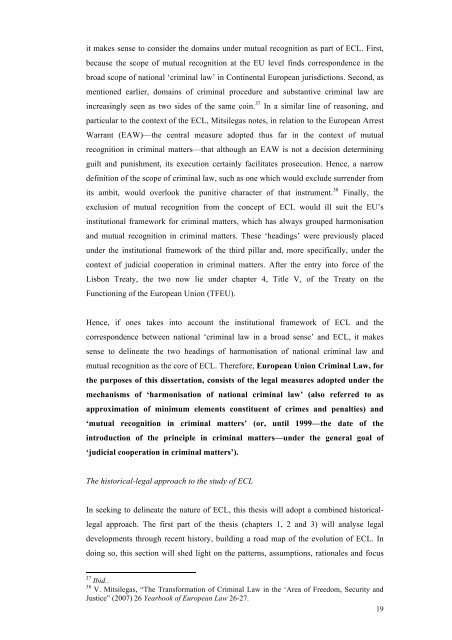The evolution of European Union criminal law (1957-2012)
The evolution of European Union criminal law (1957-2012)
The evolution of European Union criminal law (1957-2012)
Create successful ePaper yourself
Turn your PDF publications into a flip-book with our unique Google optimized e-Paper software.
it makes sense to consider the domains under mutual recognition as part <strong>of</strong> ECL. First,<br />
because the scope <strong>of</strong> mutual recognition at the EU level finds correspondence in the<br />
broad scope <strong>of</strong> national ‘<strong>criminal</strong> <strong>law</strong>’ in Continental <strong>European</strong> jurisdictions. Second, as<br />
mentioned earlier, domains <strong>of</strong> <strong>criminal</strong> procedure and substantive <strong>criminal</strong> <strong>law</strong> are<br />
increasingly seen as two sides <strong>of</strong> the same coin. 37 In a similar line <strong>of</strong> reasoning, and<br />
particular to the context <strong>of</strong> the ECL, Mitsilegas notes, in relation to the <strong>European</strong> Arrest<br />
Warrant (EAW)—the central measure adopted thus far in the context <strong>of</strong> mutual<br />
recognition in <strong>criminal</strong> matters—that although an EAW is not a decision determining<br />
guilt and punishment, its execution certainly facilitates prosecution. Hence, a narrow<br />
definition <strong>of</strong> the scope <strong>of</strong> <strong>criminal</strong> <strong>law</strong>, such as one which would exclude surrender from<br />
its ambit, would overlook the punitive character <strong>of</strong> that instrument. 38 Finally, the<br />
exclusion <strong>of</strong> mutual recognition from the concept <strong>of</strong> ECL would ill suit the EU’s<br />
institutional framework for <strong>criminal</strong> matters, which has always grouped harmonisation<br />
and mutual recognition in <strong>criminal</strong> matters. <strong>The</strong>se ‘headings’ were previously placed<br />
under the institutional framework <strong>of</strong> the third pillar and, more specifically, under the<br />
context <strong>of</strong> judicial cooperation in <strong>criminal</strong> matters. After the entry into force <strong>of</strong> the<br />
Lisbon Treaty, the two now lie under chapter 4, Title V, <strong>of</strong> the Treaty on the<br />
Functioning <strong>of</strong> the <strong>European</strong> <strong>Union</strong> (TFEU).<br />
Hence, if ones takes into account the institutional framework <strong>of</strong> ECL and the<br />
correspondence between national ‘<strong>criminal</strong> <strong>law</strong> in a broad sense’ and ECL, it makes<br />
sense to delineate the two headings <strong>of</strong> harmonisation <strong>of</strong> national <strong>criminal</strong> <strong>law</strong> and<br />
mutual recognition as the core <strong>of</strong> ECL. <strong>The</strong>refore, <strong>European</strong> <strong>Union</strong> Criminal Law, for<br />
the purposes <strong>of</strong> this dissertation, consists <strong>of</strong> the legal measures adopted under the<br />
mechanisms <strong>of</strong> ‘harmonisation <strong>of</strong> national <strong>criminal</strong> <strong>law</strong>’ (also referred to as<br />
approximation <strong>of</strong> minimum elements constituent <strong>of</strong> crimes and penalties) and<br />
‘mutual recognition in <strong>criminal</strong> matters’ (or, until 1999—the date <strong>of</strong> the<br />
introduction <strong>of</strong> the principle in <strong>criminal</strong> matters—under the general goal <strong>of</strong><br />
‘judicial cooperation in <strong>criminal</strong> matters’).<br />
<strong>The</strong> historical-legal approach to the study <strong>of</strong> ECL<br />
In seeking to delineate the nature <strong>of</strong> ECL, this thesis will adopt a combined historicallegal<br />
approach. <strong>The</strong> first part <strong>of</strong> the thesis (chapters 1, 2 and 3) will analyse legal<br />
developments through recent history, building a road map <strong>of</strong> the <strong>evolution</strong> <strong>of</strong> ECL. In<br />
doing so, this section will shed light on the patterns, assumptions, rationales and focus<br />
37 Ibid..<br />
38 V. Mitsilegas, “<strong>The</strong> Transformation <strong>of</strong> Criminal Law in the ‘Area <strong>of</strong> Freedom, Security and<br />
Justice” (2007) 26 Yearbook <strong>of</strong> <strong>European</strong> Law 26-27.<br />
19
















